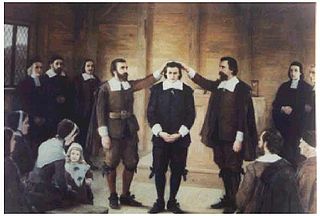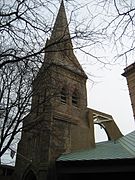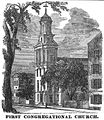Solomon Stoddard was the pastor of the Congregationalist Church in Northampton, Massachusetts Bay Colony. He succeeded Rev. Eleazer Mather, and later married his widow around 1670. Stoddard significantly liberalized church policy while promoting more power for the clergy, decrying drinking and extravagance, and urging the preaching of hellfire and the Judgment. The major religious leader of what was then the frontier, he was known as the "Puritan Pope of the Connecticut River valley" and was concerned with the lives of second-generation Puritans. The well-known theologian Jonathan Edwards (1703–1758) was his grandson, the son of Solomon's daughter, Esther Stoddard Edwards. Stoddard was the first librarian at Harvard University and the first person in American history known by that title

John Cotton was a clergyman in England and the American colonies, and was considered the preeminent minister and theologian of the Massachusetts Bay Colony. He studied for five years at Trinity College, Cambridge, and nine years at Emmanuel College, Cambridge. He had already built a reputation as a scholar and outstanding preacher when he accepted the position of minister at St. Botolph's Church, Boston, in Lincolnshire, in 1612.

John Davenport was an English Puritan clergyman and co-founder of the American colony of New Haven.
Leonard Hoar was an English-born American Congregational minister and educator, who spent a short and troubled term as President of Harvard College.

Charles Chauncy was an Anglo-American Congregational clergyman, educator, and secondarily, a physician. He was the second President of Harvard.

Richard Mather was a New England Puritan minister in colonial Boston. He was father to Increase Mather and grandfather to Cotton Mather, both celebrated Boston theologians.

The Cambridge Platform is a statement describing the system of church government in the Congregational churches of colonial New England. It was written in 1648 in response to Presbyterian criticism and eventually came regarded as the religious constitution of Massachusetts. The platform explained and defended the practice of congregational polity in New England and also endorsed the majority of the Westminster Confession of Faith. The document was shaped primarily by the thinking of Puritan ministers Richard Mather and John Cotton.

First Parish in Cambridge is a Unitarian Universalist church, located in Harvard Square in Cambridge, Massachusetts. It is a Welcoming Congregation and a member of the Unitarian Universalist Association. The church is notable for its almost 400-year history, which includes pivotal roles in the development of the early Massachusetts government, the creation of Harvard College, and the refinement of current liberal religious thought.

The Old Ship Church is a Puritan church built in 1681 in Hingham, Massachusetts. It is the only surviving 17th-century Puritan meetinghouse in America. Its congregation, gathered in 1635 and officially known as First Parish in Hingham, occupies the oldest church building in continuous ecclesiastical use in the United States. On October 9, 1960, it was designated a National Historic Landmark and on November 15, 1966, it was added to the National Register of Historic Places.

Thomas Carter was an American colonist and Puritan minister. Educated at Cambridge, he left England and emigrated to the American colonies during the Puritan Great Migration. Carter was ordained as a Puritan minister in 1642, becoming the first person in the American colonies to receive a Christian ordination. He served as a church elder and minister in Dedham, Watertown, and Woburn. A prominent religious figure in the Massachusetts Bay Colony, Carter was one signers of the Dedham Covenant and one of the founders of Woburn.

The Hollis Street Church in Boston, Massachusetts, was a Congregational and Unitarian church. It merged with the South Congregational Society of Boston in 1887.

John Clarke (1755–1798) was a minister of the First Church in Boston, Massachusetts, in the late 18th century. He was born in Portsmouth, New Hampshire, on April 13, 1755, to John Clarke and Sarah Clarke. He was educated at the Boston Public Latin School and Harvard University. He joined the ministry of Boston's First Church in January 1778, and remained there until his death at age 42. He was a charter member of the American Academy of Arts and Sciences in 1780. He was associated with the Boston Library Society; the Humane Society of Massachusetts; and the Massachusetts Historical Society. Clarke married Esther Orne; they had four children. He died in Boston on April 2, 1798.

Thomas Foxcroft (1697–1769) was a minister of the First Church in Boston, Massachusetts in the 18th century.

The Second Church (1649–1970) in Boston, Massachusetts, was first a Congregational church, and then beginning in 1802, a Unitarian church. The congregation occupied a number of successive locations around town, including North Square, Hanover Street, Copley Square, and the Fenway. Ministers included Michael Powell, Increase Mather, Cotton Mather, and Ralph Waldo Emerson. In 1970 it merged with Boston's First Church.
Samuel Skelton was the first pastor of the First Church of Salem, Massachusetts, which is the original Puritan church in North America.

John Wilson was a Puritan clergyman in Boston in the Massachusetts Bay Colony, and the minister of the First Church of Boston from its beginnings in Charlestown in 1630 until his death in 1667. He is most noted for being a minister at odds with Anne Hutchinson during the Antinomian Controversy from 1636 to 1638, and for being an attending minister during the execution of Mary Dyer in 1660.

The First Church in Roxbury, also known as the First Church of Roxbury is the current headquarters of the Unitarian Universalist ("UU") Urban Ministry. A church on this site has been in use since 1632 when early English settlers built the first meetinghouse. Since then, the meetinghouse has been rebuilt four times, and its appearance today reflects how the meetinghouse looked in the late 19th and early 20th centuries.

Congregationalism in the United States consists of Protestant churches in the Reformed tradition that have a congregational form of church government and trace their origins mainly to Puritan settlers of colonial New England. Congregational churches in other parts of the world are often related to these in the United States due to American missionary activities.

Zechariah Symmes was an English Puritan clergyman who emigrated to the Massachusetts Bay Colony in New England and became pastor of the First Church in Charlestown, an office he held continuously from 1634 to his death in 1671. Although not one of the original Charlestown founders of 1629, on arrival in 1634 he swiftly found his place among them in the church they had convened two years previously. One of the many emigrant ministers who emerged from Emmanuel College, Cambridge, he was a close fellow-worker among the leading lights of the "Bible Commonwealth".




































